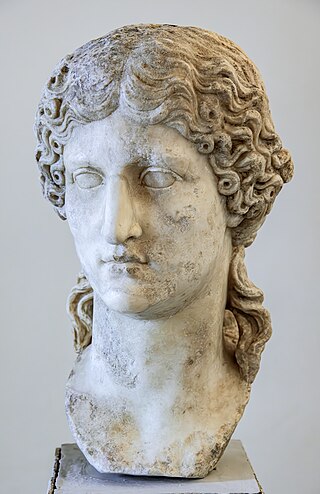
(Vipsania) Agrippina the Elder was a prominent member of the Julio-Claudian dynasty. She was the daughter of Marcus Vipsanius Agrippa and Augustus' daughter, Julia the Elder. Her brothers Lucius and Gaius Caesar were the adoptive sons of Augustus, and were his heirs until their deaths in AD 2 and 4, respectively. Following their deaths, her second cousin Germanicus was made the adoptive son of Tiberius, Augustus' stepson, as part of the succession scheme in the adoptions of AD 4. As a result of the adoption, Agrippina was wed to Germanicus in order to bring him closer to the Julian family.

Julia Agrippina, also referred to as Agrippina the Younger, was Roman empress from 49 to 54 AD, the fourth wife and niece of Emperor Claudius, and the mother of Nero.
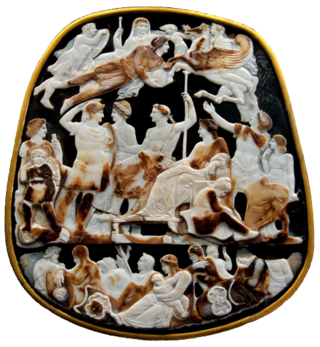
The Julio-Claudian dynasty comprised the first five Roman emperors: Augustus, Tiberius, Caligula, Claudius, and Nero.
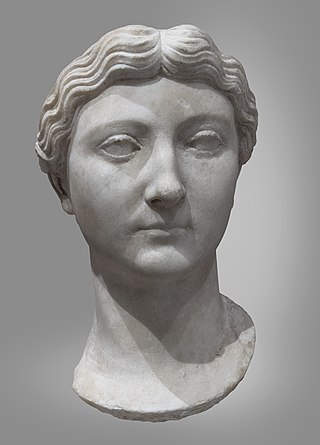
Livia Drusilla was Roman empress from 27 BC to AD 14 as the wife of emperor Augustus. She was known as Julia Augusta after her formal adoption into the Julian family in AD 14.
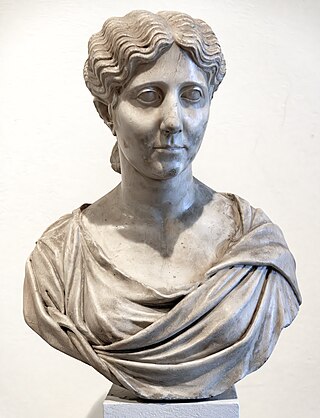
Antonia Minor was the younger of two surviving daughters of Mark Antony and Octavia Minor. She was a niece of the Emperor Augustus, sister-in-law of the Emperor Tiberius, paternal grandmother of the Emperor Caligula and Empress Agrippina the Younger, mother of the Emperor Claudius, and maternal great-grandmother of the Emperor Nero. She outlived her husband Drusus, her oldest son, her daughter, and several of her grandchildren.
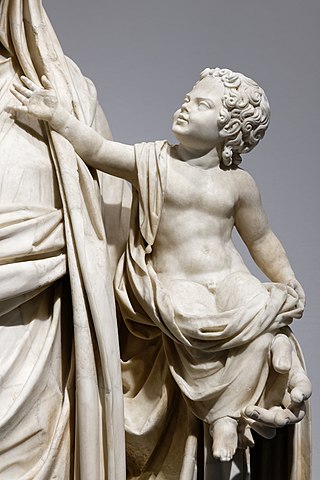
Tiberius Claudius Caesar Britannicus, usually called Britannicus, was the son of Roman Emperor Claudius and his third wife, Valeria Messalina. For a time, he was considered his father's heir, but that changed after his mother's downfall in 48, when it was revealed she had engaged in a bigamous marriage without Claudius' knowledge. The next year, his father married Agrippina the Younger, Claudius' fourth and final marriage. Their marriage was followed by the adoption of Agrippina's son, Lucius Domitius, whose name became Nero as a result. His stepbrother would later be married to Britannicus' sister Octavia and soon eclipsed him as Claudius' heir. After his father's death in October 54, Nero became emperor. The sudden death of Britannicus shortly before his fourteenth birthday is reported by all extant sources as being the result of poisoning on Nero's orders; as Claudius' biological son, he represented a threat to Nero's claim to the throne.

Cameo is a method of carving an object such as an engraved gem, item of jewellery or vessel. It nearly always features a raised (positive) relief image; contrast with intaglio, which has a negative image. Originally, and still in discussing historical work, cameo only referred to works where the relief image was of a contrasting colour to the background; this was achieved by carefully carving a piece of material with a flat plane where two contrasting colours met, removing all the first colour except for the image to leave a contrasting background.

Claudia Livia was the only daughter of Nero Claudius Drusus and Antonia Minor and sister to Roman Emperor Claudius and general Germanicus, and thus paternal aunt of emperor Caligula and maternal great-aunt of emperor Nero, as well as the niece and daughter-in-law of Tiberius. She was named after her grandmother, Augustus' wife Livia Drusilla, and commonly known by her family nickname Livilla. She was born after Germanicus and before Claudius.

The art of Ancient Rome, and the territories of its Republic and later Empire, includes architecture, painting, sculpture and mosaic work. Luxury objects in metal-work, gem engraving, ivory carvings, and glass are sometimes considered to be minor forms of Roman art, although they were not considered as such at the time. Sculpture was perhaps considered as the highest form of art by Romans, but figure painting was also highly regarded. A very large body of sculpture has survived from about the 1st century BC onward, though very little from before, but very little painting remains, and probably nothing that a contemporary would have considered to be of the highest quality.

Nero Julius Caesar was the adopted grandson and heir of the Roman Emperor Tiberius, alongside his brother Drusus. Born into the prominent Julio-Claudian dynasty, Nero was the son of Tiberius' general and heir, Germanicus. After the deaths of his father and of Tiberius' son, Drusus the Younger, Nero and his brother Drusus were adopted together by Tiberius in September AD 23. As a result of being heirs of the emperor, he and his brother enjoyed accelerated political careers.

Julia Livilla was the youngest child of Germanicus and Agrippina the Elder and the youngest sister of the Emperor Caligula.

The Gemma Augustea is an ancient Roman low-relief cameo engraved gem cut from a double-layered Arabian onyx stone. It is commonly agreed that the gem cutter who created it was either Dioscurides or one of his disciples, in the second or third decade of the 1st century AD.

The study of Roman sculpture is complicated by its relation to Greek sculpture. Many examples of even the most famous Greek sculptures, such as the Apollo Belvedere and Barberini Faun, are known only from Roman Imperial or Hellenistic "copies". At one time, this imitation was taken by art historians as indicating a narrowness of the Roman artistic imagination, but, in the late 20th century, Roman art began to be reevaluated on its own terms: some impressions of the nature of Greek sculpture may in fact be based on Roman artistry.

Octavia the Younger was the elder sister of the first Roman Emperor, Augustus, the half-sister of Octavia the Elder, and the fourth wife of Mark Antony. She was also the great-grandmother of the Emperor Caligula and Empress Agrippina the Younger, maternal grandmother of the Emperor Claudius, and paternal great-grandmother and maternal great-great-grandmother of the Emperor Nero.

Caesar Augustus, known as Octavian before he became emperor, was the first and among the most important of the Roman Emperors and is one of the most influential figures in Western history. As such, he has frequently been depicted in literature and art since ancient times.

The Great Cameo of France is a five-layered sardonyx Imperial Roman cameo of either about 23 AD, or 50–54 AD. It is 31 cm by 26.5 cm. It is now in the Bibliothèque Nationale in Paris.
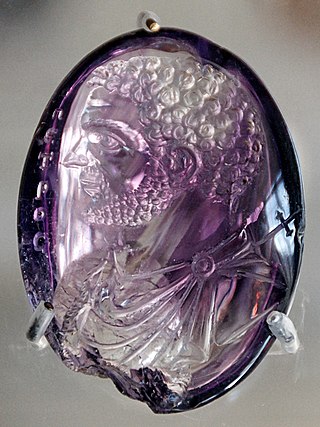
An engraved gem, frequently referred to as an intaglio, is a small and usually semi-precious gemstone that has been carved, in the Western tradition normally with images or inscriptions only on one face. The engraving of gemstones was a major luxury art form in the Ancient world, and an important one in some later periods.

The Gonzaga Cameo is a Hellenistic engraved gem; a cameo of the capita jugata variety cut out from the three layers of an Indian sardonyx, dating from perhaps the 3rd century BC. It was a centrepiece of the Gonzaga collection of antiquities, first described in a 1542 inventory of Isabella d'Este's collection as representing Augustus and Livia. The figures were later identified as Alexander the Great and Olympias, Germanicus and Agrippina the Elder, Nero and Agrippina the Younger, and many other famous couples of antiquity. The male figure on the cameo is clad in the attributes of Alexander, including a laurel-wreathed helmet, and wears a gorgoneion. His other aegis represents a bearded head, probably that of Zeus Ammon. The man's laurel wreath is crowned by a snake which suggests the uraeus. The contrasting male and female profiles were in all probability intended to suggest Zeus and Hera. The brown necklace is a later addition masking that the cameo was, at some point, broken in half.
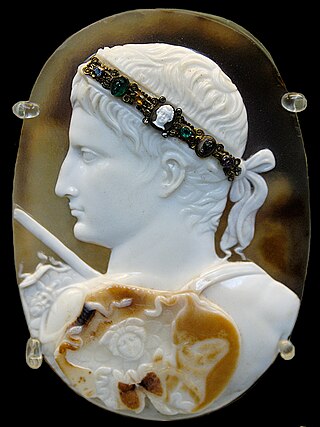
The Blacas Cameo is an unusually large Ancient Roman cameo, 12.8 cm (5.0 in) high, carved from a piece of sardonyx with four alternating layers of white and brown. It shows the profile head of the Roman emperor Augustus and probably dates from shortly after his death in AD 14, perhaps from AD 20–50. It has been in the British Museum since 1867, when the museum acquired the famous collection of antiquities that Louis, Duke of Blacas had inherited from his father, also including the Esquiline Treasure. Normally it is on display in Room 70.

Augustan and Julio-Claudian art is the artistic production that took place in the Roman Empire under the reign of Augustus and the Julio-Claudian dynasty, lasting from 44 BC to 69 AD. At that time Roman art developed towards a serene "neoclassicism", which reflected the political aims of Augustus and the Pax Romana, aimed at building a solid and idealized image of the empire.




















